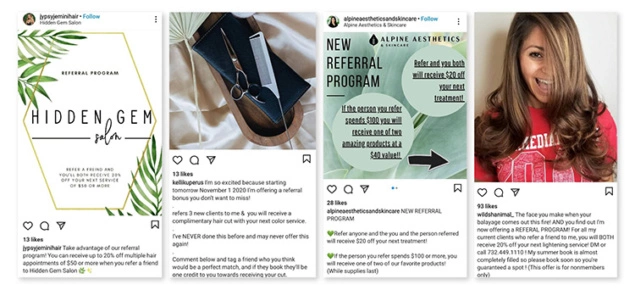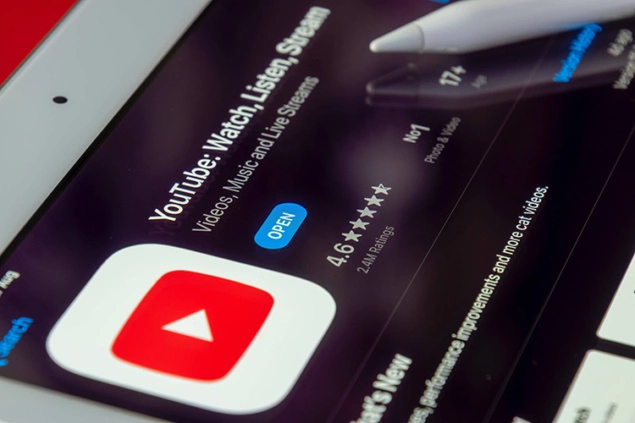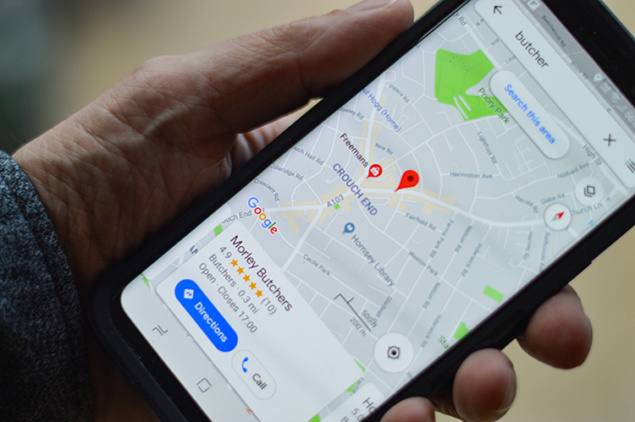Effective marketing is arguably the most crucial part of any business. Without it, customers simply won’t know about your brand, products, or services, and your business will fail. But despite knowing how essential marketing is, any small business owner knows that a great marketing strategy can be expensive, complicated, and potentially overwhelming.
But what if we told you it’s possible to promote your business without having to fork over thousands of dollars to an over-primped, so-called “marketing expert?” In fact, many of the best marketing ideas are incredibly cheap or even free to take advantage of.
Top 30 small business marketing ideas
From social media to email marketing, these top 30 small business marketing ideas (in no particular order) are the perfect way for a small business owner to get their brand out there, collect some new customers, and build a successful business.
1. Put more effort into your business cards.
Although the wonderful world wide web has mostly taken over when it comes to marketing efforts, the old-school business card still has a place when it comes to promoting your business. But don’t stick with the same boring white and blue design that hundreds of other businesses are using… Take some time to create eye-catching and exciting cards that match your brand and will stand out in a pile. Match the color scheme to your website and other branding, and you could even utilize color psychology to influence a desired reaction.

2. Host a free event or class
Who doesn’t love a freebie? Hosting free classes, events, or seminars is a great way to educate potential customers about your industry and business. Not only will the audience walk away feeling like they’ve got something valuable from the experience, but these events will also secure your reputation as an industry expert and will make your brand instantly memorable.
If these aren’t good enough reasons for you to consider sharing your expertise, it’s also worth noting that local establishments (like libraries, coffee shops, etc.) will generally be much happier with you posting a flyer for a free event than a blatant advertisement. Be sure to include your business name, logo, and any other branding clearly on the flyer for some free and easy advertising.
3. Attend conferences and networking events
If you don’t have the resources to host your own events (or even if you do), attending conferences and other industry events can be a fantastic way to build your brand presence with people who are already interested.
If you can, contact the event organizers to find out whether you could set up a booth or even speak at the event. If not, just hearing what advice other experts and industry leaders have to offer can be incredibly valuable.
In terms of cost, although some conferences are free to attend, most aren’t and can be costly when you factor in travel expenses. This means it might not be a viable option for all small business owners. However, if you keep an eye open, you might be surprised how many affordable events are going on in your local area and how many networking opportunities you can attend.
4. Start (or promote) a customer referral program
Research consistently shows that 92% of people trust recommendations from friends and family above all other types of marketing. So, if you have happy customers, why not incentivize them to share the love with a customer referral program?
Whether you offer money off future purchases when you refer a friend, operate a points system, or provide free samples… Encouraging customers to tell their friends and family about your business is an excellent way to build brand awareness and make customers feel special.
In addition to referral benefits, a loyalty program is another excellent way to keep customers coming back for more (and hopefully recommending your brand). Be sure to promote the benefits of any loyalty or referral marketing programs at every opportunity, so customers know these options are out there.

5. Participate in online forums
Online forums are a bit like virtual conventions in that they’re both full of industry-specific conversations you can get involved in. Forums like Reddit, Quora, Medium, etc., are fantastic platforms for establishing your brand as an industry expert, making new connections, or even finding new business contacts!
If your marketing efforts focus on online forums, it is vital to be wary of self-promotion. Users (and even the forums themselves) can be very dismissive of blatant marketing, and you can even end up flagged as spam. To ensure this doesn’t happen, answer questions as genuinely and helpfully as possible to build your name and reputation. You’ll get much better responses if you don’t look like you’re cruising for customers.

6. Support a cause that matches your brand’s values
Sponsoring a charity, event, or cause that aligns with your company values is a great way to show your customers that you care about the things they care about and that your business is about more than making money. In fact, many of the top Shopify stores support at least one good cause and are clear about being a force for good.
If you’re not sure what to support, take another look at your mission statement. Consider the values closest to your company’s heart and look for events or charities you could get involved in that directly influence these values. Your customers will love that you’re doing more than just talking about it and may even start to associate your brand with the feel-good emotions that come from helping others.
There are a few options for supporting a cause. It could be as simple as a financial donation (“X% of profits support…”), donating products or services pro-bono or as a prize, allow events to be hosted on your premises… The sky is the limit!
7. Utilize vehicle branding
If you drive around regularly, utilizing vehicle branding can be an excellent way to build brand awareness. Think of it as transforming your car into a mobile billboard. If you have a fleet (or friends and family who don’t mind “pimping” their vehicles a little), that’s even better, as you can benefit from multiple advertisements every time you go out.
Generally, vehicle branding will involve wrapping the car or van with a sticker and can be done relatively inexpensively. If you don’t want a full wrap, you could also order car magnets with your name and logo.
If this inspires you, there are many other similar ways to market your business by transforming everyday objects and events into affordable marketing ideas. These days, almost anything can be feature branding. Try branded pens, coasters, post-it notes, or even guitar picks and give them away at events. Branded clothing is also a brilliant way to build brand awareness while you’re out and about.

8. Ask for, respond to, and monitor reviews.
We mentioned already that 92% of consumers trust recommendations from friends and family over all other types of advertising… But did you know that 88% of people trust online reviews (written by real past customers) just as much?
Make sure to ask your customers to review their purchases so others can see how satisfied your existing clients are, and then respond to these reviews to demonstrate that your brand cares about its customers.
Remember, not every review will always be positive. It’s also important not to simply delete negative posts but respond to them professionally to improve the customer experience. In many instances, this will involve resolving the matter offline. If so, be sure to return to the original review with a note letting other customers know the issue has been addressed.
Taking care with customer feedback is one of the best ways to market a small business as it costs nothing except a small amount of your time to respond and offers so many benefits.
9. Send out customer satisfaction surveys.
If you’re not getting enough reviews for a product or service, it can be beneficial to reach out to your customers directly to ask how you can improve their experience. Simply asking customers and potential customers what they want is a frequently overlooked but incredibly valuable marketing strategy that can provide astounding insights.
You can send out satisfaction surveys as part of your email marketing plan or even provide pen and paper surveys for customers to fill out in-store for a more personal touch. Your customers will be thrilled that you’ve asked their opinion and may even feel invested in the results of the survey… Leading them to return to your business to see whether you’ve implemented any changes following their feedback.

10. Create and share infographics
Infographics and other visual guides are handy marketing tools that can often be overlooked by small business owners. Not only are they a fun and unique way of getting important information across to customers, but studies show that people respond well to this marketing medium, and it’s a great way to keep readers engaged.
Infographics are particularly beneficial for use in social media marketing. In fact, Facebook posts with infographics receive approximately double the number of comments than other content.
If that’s not enough, potential customers will find image-based content (particularly if it features your business’ branding and color scheme) more memorable than pure text. So if you’re trying to learn how to market your business, you can’t go far wrong with a few helpful infographics.
11. Use numbers to tell your story
You might be surprised to learn that numbers can be the best way to market your small business… but hear us out.
Numbers and figures provide a target audience with an easily digestible reference point that supports any claims your business is making. For example, rather than saying “most loved in the community,” try “over 5,000 happy customers in the area.” Using numbers makes a claim quantifiable and feels more believable than an out-there declaration.
In addition to using real figures as part of your marketing plan to help your brand feel more genuine, sharing relevant academic studies (and highlighting the important bits) or any other in-depth research can be a fantastic way to spice up your elevator pitch and help you stand out.
12. Give guerrilla marketing a try!
Even if you’ve never heard of guerrilla marketing, chances are you’ve seen it around… And we believe it’s one of the absolute best ways to market a new small business.
This unique marketing strategy involves using unusual and unexpected methods to attract new customers and make people think.
You can get started with guerrilla marketing with as little as some chalk and a sidewalk, stickers, graffiti (with permits, of course!), or pretty much anything else you can think of. As long as it’s creative and fun, you’ll be amazed at how beneficial some well-done guerrilla-ing can be!
Do it well… And you might even find yourself with a social media sensation.

13. Engage on social media
You shouldn’t need us to tell you that social media marketing is essential for any business, big or small. And if you’re not using social media effectively, then you’re missing out on a vast audience of potential customers.
We could rave about social media as a marketing tool all day long, and dozens of social media marketing statistics back up why it’s so important to be active online…
…What we will tell you is that it’s not enough to simply have a presence on social media platforms. You need to complete plenty of target market research to figure out which platforms are actually being used by your target market and how to engage effectively.
Whether you stick with the classic Facebook, Instagram, and Twitter or engage with younger audiences on video-friendly platforms like TikTok, without sufficient research, you might find you’re not using social media to its full potential.
What’s even better is that small-medium businesses don’t need to spend a fortune on social media advertising. You can do well simply by writing regular social media posts and engaging with your followers on whatever platform(s) you select.
If you want to get your social media advertising to the next level, there are loads of tools, such as Facebook ads, that make it easy to cover the basics of marketing for small businesses and entrepreneurs to get started building a social presence.
14. Send out email newsletters
After social media, email marketing is arguably the best way to market a new small business as it involves engaging with people who have already expressed interest in your brand, product, or service.
In fact, 72% of US adults stated they prefer companies to communicate with them via email, and 91% actually want to receive promotional material via email from companies they do business with.
These stats shouldn’t be ignored, and if you don’t already have an email marketing strategy in place, you really need to fix that! Promote your email newsletter throughout your website and on your social media pages. You might even offer a discount or loyalty program to encourage people to sign up.
Don’t forget to add a call to action in every email.
Not sure you have the time to run an email marketing campaign? There are loads of email marketing tools available to help you find the perfect balance and send out regular, engaging emails that your readers will be excited to receive.

15. Host a “business cards in a bowl” competition
If you have a physical store or premises, hosting a classic “cards in a bowl” competition to win a free sample of your product or service (or another prize) can be an excellent way to promote your business and collect customer data. Business cards are a precious asset as they are likely to contain contact information such as email addresses that you can use for other campaigns.
Although these might not be the most innovative business marketing ideas, sometimes things are classic for a reason, and you might be surprised how many sales and promotion opportunities come from this simple game.
16. Consider creating a company mascot.
Tony the Tiger, Ronald McDonald, the Jolly Green Giant, Mr. Peanut, the Geico lizard, Chester Cheeto… These instantly recognizable customer mascots are more than a cute addition to a brand’s identity; they actually serve a significant role in business marketing.
Mascots are among our favorite marketing ideas for small businesses as they help build a distinct personality and identity for your brand that an audience will remember and associate with.
You can use your mascot in all your content marketing, online and offline, and even have them evolve with your company as it grows. Over time, people will think of your company mascot first, and you can benefit from an emotional bond that your audience builds with the mascot.

17. Write a blog
When it comes to SEO (Search Engine Optimization), there’s little that can compete with the benefits of a blog on your website. Not only will a well-written and informative blog help establish you as an expert in your industry, but carefully chosen keywords and phrases will help your blog posts and website rank higher in search engine results (let’s be honest, we never go to page 2 on Google!).
Blog posts are probably the best way to drive traffic to your website or online store and can be an excellent way to convert prospects into sales.
It’s crucial to ensure your blog is related to your industry and your products or services and that you find the right balance between utilizing keywords and SEO vs. not stuffing your article with irrelevant search terms.
Blogging is definitely among the small business marketing fundamentals, and there are plenty of handy SEO checklists to help you create an awesome blog that readers will love. Just be sure to complete your target research to attract and retain the right audience.
18. Start a YouTube channel
YouTube is the second-largest search engine on the internet (after Google), with over 34 billion website visits per month, so there’s a massive audience using the platform.
Now that you can shoot professional-standard video with just a smartphone, video should undoubtedly be part of your online marketing strategy and doesn’t need to break your budget.
If you don’t fancy creating full feature-length videos for your channel, YouTube has also made it incredibly convenient (and free!) to create short video ads with a free video builder tool that’s easy to use and is filled with advertising tips for new businesses to help your ads stand out.

19. Sign up for HARO (Help A Reporter Out)
HARO (Help A Reporter Out) is an inventive way to satisfy your small marketing needs even if you’re working with no budget. The website connects journalists with industry experts who can help them write their stories and is a brilliant way to get your business in the news for all the right reasons.
Obviously, you should only be offering assistance on articles related to your company and topics your ideal customer is likely to be interested in. Get it right, and you’ll effectively receive free ads that could turn into website traffic or a committed buyer who trusts your brand.
20. Claim your business on Google
It’s probably safe to say that when you’re looking for a business, product, or service, chances are you go straight to Google to find all the information you could need about them. Therefore, if your company isn’t correctly listed on the platform, you could be missing out on millions of buyer prospects.
Having a correctly set up Google business page is one of the best ways to drive traffic to your website. It will also make your brand look more respectable and ensures customers can contact you easily. Plus, you’ll even show up on Google maps, so local buyers can find your physical store easily.
To get started claiming your company on Google, you’ll need a Google Account. After this, the process is relatively straightforward, and there are even customization options to ensure your brand is presented the way you want.

21. Manage your Yelp presence
After Google, Yelp is the top review site for local businesses and benefits from an average of over 145 million users every month. Therefore, it’s vital to have your business listed on the platform to ensure you’re discoverable to potential customers.
For small business owners on a budget, it’s free to set up and manage a Yelp business page. However, there are some costs if you want to upgrade your page. These include $1 per day for upgrades like adding a call to action button or removing competitor ads from your page. Yelp Advertising also comes with costs per impression, so watch out for these.
22. Partner with social media influencers
An influencer partnership marketing strategy can be an excellent way to take your social media and brand awareness to the next level.
This partnership allows you to benefit from an already popular social media account’s reputation. It is a fantastic way to get your product, service, or brand in front of a wider audience.
Partnering with a social media influencer can provide a considerable boost to your social presence, and it can be as affordable or expensive as you like, depending on the influencer you choose to partner with.
But even when influencer marketing feels out of budget, it’s worth remembering that 89% of marketing professionals believe the ROI on influencer marketing is the same or more effective than any other marketing strategy. So, it’s a worthwhile investment.

23. Host a webinar
Earlier in our list of marketing help for small businesses, we mentioned the benefits of hosting a free event or class to attract your target customer… But even if you’re an online-only company, you can still benefit from offering free information if you create a webinar that people can join remotely.
A good webinar should be filled with helpful information and tips that will benefit the customer and be readily available. You can gain traffic and build excitement for the online event by posting on your social media platforms. Remember to include a call to action and link to the webinar on all your ads.

24. Run competitions and contests
Competitions and contests are a tried and tested method for marketing a small service business and shouldn’t be overlooked. You can run competitions on Facebook, host video competitions on TikTok, or even create an online game with real prizes up for grabs to post on your website.
Free products or complimentary services are brilliant prizes, and asking participants to share the contest with their own followers will ensure you can attract a wider audience.
In addition, hosting contests is a fantastic opportunity to collect consumer data. You might ask users to include their email address or social media page, which can be used as part of future marketing campaigns (although be sure to gain their permission first).
25. Apply for business awards
Winning a business award is a fantastic way to demonstrate that you’re a great brand and will earn you countless trustworthiness points in a buyer’s mind. Whether you’re applying for a Witch recommendation or a rating in a local magazine, being an award-winning company is always worth boasting about.
26. Offer free samples or coupons
As we’ve already mentioned, everybody loves free things. And although a small-medium business might not be able to give away all its products or services, offering prizes or money-off coupons can be a fantastic way to keep a buyer feeling engaged and valued.
Free samples or services could be given away as prizes for competitions, as part of a loyalty program, or even as a random “thank you.” If you don’t have the budget to provide entirely free perks, consider coupons or gift vouchers for loyal customers or create exclusive deals and bespoke upsells to demonstrate how much you appreciate them.

27. Update your website
In addition to relevant blog posts with excellent SEO, optimizing your website from a technical point of view will help grow traffic, attract more customers, and boost sales.
No matter how attractive and search-engine-friendly your site is, if it has slow loading times or is difficult to navigate, you’ll lose visitors before you even get them. In fact, Google researchers found that 53% of mobile traffic will abandon your site if a page takes over three seconds to load. Mobile sites that loaded within 5 seconds (compared to 19) benefited from 25% higher ads visibility, 70% longer browsing sessions, and a 35% lower bounce rate.
So, get your website optimized. We won’t say it again.
28. Try offline advertising
Obviously, online marketing will take up a significant section of your marketing budget as we live in an increasingly virtual world. However, that doesn’t mean you should abandon more traditional marketing methods entirely.
Old-school advertising such as billboards, sidewalk signs, and even newspaper ads still have their place in building brand awareness. If you have a recognizable brand name, logo, design, or mascot, get it out there. Make sure prospects in your local area know who you are.
To take your traditional adverts to the next level, you could also record short ads for radio or local TV. Depending on your target audience, you might find some budget-friendly options to get your message across to the right people. For example, if your target audience is new moms, placing a TV ad on an early-morning kid’s show could be a fantastic opportunity to speak to your audience.

29. Recycle old marketing material
One of the best advertising tips for new business owners that we’ve found is not to be afraid to repurpose old content. Whether it’s sharing an old Facebook post that’s cropped up in your Memories or highlighting a previous blog post that’s full of valuable data, there’s no reason your hard work needs to be a one-time-only event.
Naturally, this doesn’t mean create the same old video or post hundreds of times and bore your audience… But it does mean that if you’ve created the perfect content in the past, you can absolutely bring it back into focus at a later date.
30. Take advantage of automation tools.
When you’re first learning how to market a company, it’s easy to get bogged down thinking you have to do it all yourself (or hire someone to manually do it for you). But working this way will quickly drain your budget and leave you feeling burned out.
With marketing automation tools, you can make sales and drive traffic virtually effortlessly, so you can focus on your business and aren’t wasting manpower on every post.

Advertise to the right people
Now you’ve read some of our top tips on how to do marketing for small businesses without breaking the bank, you should have plenty of inspiration to create innovative and engaging marketing campaigns your audience will love.
But before you get started picking your favorite ways of marketing, you must do your research to establish what marketing methods your customers will engage with the best.
There’s no point in creating amazing videos for Facebook if your target audience is young people who prefer TikTok. Similarly, if you’re targeting an older audience, you’re probably going to have more success with an offline campaign or even a newspaper ad than you would using social media.
By figuring out your target market and audience, you’ll be able to create valuable marketing campaigns that attract the right people instead of wasting your time and money advertising to people who will never be interested. It also ensures you can find the perfect platform and channel for your campaigns.
So, with this information, what are you waiting for? Get started gathering customer data and uncover your own perfect marketing strategies.

FAQ
Which marketing is best for small businesses?
The best marketing method for your small business will depend on your budget and target audience. There’s little point in wasting time marketing on channels your customers aren’t using.
That said, Facebook Advertising is generally considered one of the best marketing channels because of how easy it is to customize your targeting and budget.
Google Ads is also an incredibly useful marketing tool that all businesses can benefit from.
If you want free marketing options, writing an SEO-friendly blog and creating a high-quality email campaign will help you drive traffic and increase sales.
How do I market my small business?
Before you create any marketing material, you need to get your business set up. This includes having a high-quality and fast-loading website, being present and active on your chosen social media channels, and claiming your business on Google and Yelp.
What are the 4 types of marketing?
- Cause marketing: Links your company, products, and services to a social cause or issue.
- Relationship marketing: Focuses on customer service, satisfaction, and retention.
- Scarcity Marketing: Marketing tactics such as “limited time” or “buy it before it goes” are used to create a feeling of urgency to encourage shoppers to buy immediately.
- Undercover marketing: Also known as “stealth” or “native” advertising. A more subtle approach to marketing that gets your brand in front of customers without them realizing they’re being advertised to.




